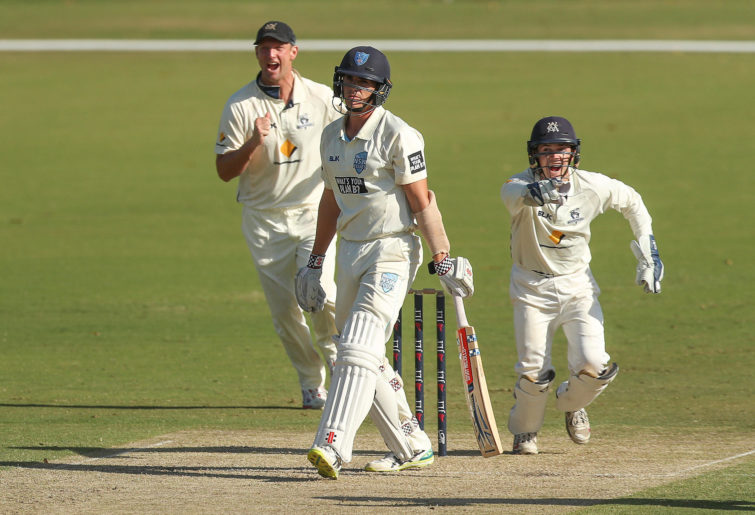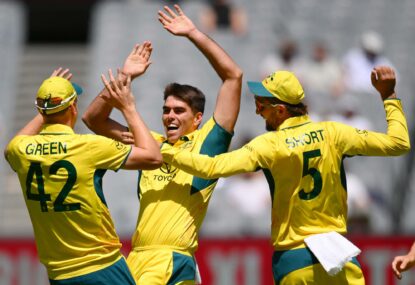For the fourth round of this year’s Sheffield Shield we were treated to two games that went down to the final session.
New South Wales came back from the brink to defeat Tasmania, while South Australia fought hard in their second innings but fell just short of escaping a loss against Queensland. The third game was less competitive as strong batting performances from Victoria and Western Australia lead to a comfortable draw.
Will Pucovski’s case is undeniable
In my four takeaways from Round 3 of the Sheffield Shield, I stated that Joe Burns would play the first Test against India, but Will Pucovski was coming hard for his spot.
With the benefit of another round of Sheffield Shield action, I am prepared to flip my position. Burns’ current form does not justify selection in the first Test team and Pucovski should be his replacement.
The stats on their own are damning. Burns has only made 57 runs from his five innings. This is poor, but looks even worse compared to Pucovski’s 495 runs in three innings. What is even more troublesome is the nature of Burns’ dismissals. In four of his five innings, Burns has been caught behind. In his other innings, he was bowled.
Burns inability to stop knicking the ball is a fatal flaw for an opening bat. Openers are selected for their ability to repel the new ball and, as such, they must know when to play and when not to play. Burns is currently getting drawn into shots and is edging behind.
Pucovski, on the other hand, looks unbeatable at the crease. It was easy to dismiss his double century against South Australia as a single performance on a flat wicket against a weak team. To score a second double-ton against a stronger team demonstrates his concentration and mental strength. His first-class average now sits at 55, which is higher than Burns has ever achieved over his career.
Pucovski is not only more talented than Burns, he is better than Burns now. Even though he is only 22 years old, selecting Pucovski is not only a selection for the future, it is a selection for now. He is the best opening batsman in this year’s Sheffield Shield and deserves the chance to play against India.

Will Pucovski. (Photo: Paul Kane/Getty Images)
New South Wales win the unwinnable, and Tasmania lose the unloseable
In their match against Tasmania, NSW lost the toss and were sent in to bat. They did not survive the first session. A mix of tight, probing bowling from the Tigers and some poor batting by NSW saw the Blues dismissed for 64. In almost 130 years of Sheffield Shield history, the Blues have only twice been dismissed for less in their first innings.
Despite starting the game as poorly as possible, NSW managed to come back to win. Whilst NSW did a lot right, Tasmania also made a lot of mistakes. The first key point of the game came at the 59 over mark of Tasmania’s first innings with only one over to go until stumps on day one.
The Tigers were three wickets down, with Jordan Silk and Jake Doran batting well. Despite trying to see out the day, Doran feathered an edge from Nathan Lyon and it changed the face of the game.
If Doran had managed to survive one more over, Tasmania would have had the chance to consolidate their innings and create a stronger lead over the Blues. Instead, they lost early wickets on day two and could only eke out a lead of 175.
By failing to get enough runs in their first innings, Tasmania gave NSW the chance to bat when the pitch was at its easiest for batting. The Blues took advantage of this and piled on a mighty second innings score. Centuries from Nick Larkin, Moises Henriques and Sean Abbott turned the game back in their favour.
Although they were now behind, Tasmania still had opportunities to save the game. To draw the game, they had to bat 110 overs. 110 overs sounds like a lot, but in this round every State other than Tasmania were able to bat in an innings for more than 110 overs.
If they were to survive this game, the first thing Tasmania had to do was minimise the damage in the 13 overs they had to bat at the end of Day 3. Instead, both of Tasmania’s openers were dismissed which immediately put the Tigers on the back foot.
On Day 4 Tasmania worked themselves back into the game and reached 2-101 with Matthew Wade batting well. The next tipping point then came a few overs before lunch on the last day. Wade and Peter Siddle had been batting well, but Nathan Lyon struck two major blows to Tasmania.
Firstly, Larkin took an excellent reflex catch to dismiss the night-watchmen Peter Siddle for 46. Wade then flicked a tame delivery from Lyon to leg-slip and Tasmania were back on the path to losing the game.
NSW deserve a great deal of respect for managing to win this match despite starting as poorly as possible. They batted brilliantly in their second innings and bowled well throughout. Yet it always takes two to tango, and Tasmania failed to take advantage of their strong position and played themselves into a loss.
Sean Abbott is placing himself into Test consideration
If there were an MVP for the first four rounds of the Sheffield Shield season, it would be hard to look past Sean Abbott. He has been the most effective fast bowler in the competition and his bowling average and his strike rate are the best in the competition by a significant margin. Despite bowling in an attack with Mitch Starc and Nathan Lyon, Abbott has also looked like NSW’s best bowler over their first three games.
Whilst Abbott’s bowling has always been the main string to his bow, in this season he has also managed to impress with the bat. In NSW’s three games, Abbott has scored two half-centuries and scored a quality hundred against Tasmania this week.

(Photo by Kelly Defina/Getty Images)
Whilst Abbott is a naturally aggressive batter, he has shown an ability to hang tough when the situation requires. In NSW’s match against Queensland, Abbott reined his game in and managed to shepherd the tail to help the Blues chase down a tough fourth-innings target.
Abbott has already been selected as part of Australia’s limited-overs teams but it is time for him to be considered closely for Australia’s Test squad. The challenge for Abbott is that Australia are already well-stocked for fast-bowling depth with Mitch Starc, Pat Cummins, Josh Hazlewood and James Pattinson being guaranteed selections.
However, Australia will look at fast-bowling depth and Abbott should be considered with Michael Neser for that role.
Which teams are well-placed heading into the break?
This was the last round of Sheffield Shield matches for the foreseeable future. It is unclear when the next games will be played. Whilst there is still a lot of cricket to be played, we have enough evidence now to suggest which teams are contenders for the Shield.
Queensland and NSW are the top two teams on the ladder and deserve their ranking. These two teams are the most well-balanced and have shown the ability to dominate games with bat and ball. NSW have the best bowling line-up in the Shield but the only question for them is whether they will maintain this level of performance once the international season commences and they lose players like Starc and Lyon.
There are also few weaknesses to Queensland’s line-up. Their bowling attack doesn’t have the star-power of NSW but is blessed with quality seam bowlers and Mitch Swepson has been the best spinner in this year’s Shield.
On the next tier of teams are Victoria and Western Australia. Both teams suffer from a similar weakness, which is an inability to bowl teams out twice. In their last three games, Western Australia have only taken a wicket every 20 overs. Western Australia lack a true front-line spinner, as Ashton Agar is better suited as an all-rounder, while there has been no consistency with their seam bowlers.
Victoria have bowled better, but they lack penetration. Scott Boland is Victoria’s best bowler, but that is damning. Boland is best suited as a first-change bowler due to his lack of speed and bounce, but Victoria don’t have the quality to allow Boland to play his best role.
On a more positive note, both teams are batting well. Western Australia have gotten contributions from across their order, with six batsmen making centuries so far. Victoria have also made big totals, although that has so far been driven by the magnificent opening contributions of Pucovksi and Marcus Harris.
On the third tier of teams, we have South Australia and Tasmania. As I wrote in my takeaways for Round 2, both of these teams will regret their ability to beat each other as it is not clear who else they can beat.
Tasmania are the better team of these two. The Tigers have shown some encouraging signs at times. When the pitches offer some assistance, their bowling attack is smart enough to post a constant threat. The issue for their bowling is when the wicket is flatter.
Bowlers like Jackson Bird and Peter Siddle are not threatening enough to dismiss teams when there isn’t a bit of help and the rest of the attack is not quite good enough. Tasmania also don’t have enough depth in their batting lineup. Outside of Matthew Wade, and the occasional glimpse from Ben McDermott, there isn’t much to be hopeful about.
South Australia have little to be excited about. In a similar vein to Tasmania, they don’t have any real strike bowlers who can dismiss quality batsmen on flat wickets. Lloyd Pope is talented but is still a few years away. Their batting has also been terribly inconsistent. In all four of their matches this year, the Redbacks have been dismissed for 200 or less in one of their innings.
Whilst they have often fought hard in their second innings, they are regularly playing from a long way behind. These consistent collapses suggest they are a team which lacks the ability and mental strength to work through challenging game situations. South Australia have a lot of work to do if they are to avoid the wooden spoon in this year’s Shield.






































































































